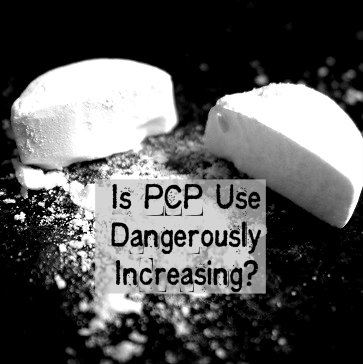Is PCP Use Dangerously Increasing?
PCP is a well-known nickname for phencyclidine, a powerful tranquilizer that, among its other effects, interferes with the ability to remain consciously connected to the self or to one’s surroundings. Since the 1960s, the tranquilizer has been purposefully or unintentionally used as a recreational drug by a small but significant number of teenagers and adults. For a long time, PCP seemed to drop in popularity among drug users. However, according to the results of a report released in November 2013 by the federal Substance Abuse and Mental Health Services Administration (SAMHSA), use of the use of PCP may be on the rise.
PCP’s Effects
 PCP produces its effects as a tranquilizer by causing dissociation, a detached mental state featuring a diminished capacity to take in the sensory information that human beings rely on to stay oriented to reality and maintain self-awareness. The drug can also produce a number of other immediate or short-term effects, including hallucinations, delusional behavior, paranoia, unusual aggression or agitation, euphoria, panic, a lack of normal mental or physical responsiveness, speaking difficulties, muscle impairment, changes in breathing and heart rates, obsessive thought patterns and depression.
PCP produces its effects as a tranquilizer by causing dissociation, a detached mental state featuring a diminished capacity to take in the sensory information that human beings rely on to stay oriented to reality and maintain self-awareness. The drug can also produce a number of other immediate or short-term effects, including hallucinations, delusional behavior, paranoia, unusual aggression or agitation, euphoria, panic, a lack of normal mental or physical responsiveness, speaking difficulties, muscle impairment, changes in breathing and heart rates, obsessive thought patterns and depression.
The specific short-term effects of PCP in any given individual depend largely on the amount of the drug he or she consumes. People who take doses well over 10 mg can experience a phencyclidine-related overdose that leads to seizures, coma or loss of life. Potential long-term effects of habitual PCP use include chronic memory problems, chronic psychosis and persistent depression or anxiety.
Tracking PCP Use
In the U.S., the federal government tracks the use of PCP and other commonly abused substances in a number of ways. For instance, the National Institute on Drug Abuse tracks usage rates among teenagers through an annual project called Monitoring the Future, which uses statistics gathered from 130 strategically chosen high schools to estimate larger national substance intake trends. The Substance Abuse and Mental Health Services Administration tracks drug use in the entire U.S. population by gathering information on drug-related incidents from emergency rooms at hospitals across the country, as well as information on drug-related deaths submitted by both coroners and medical examiners after they conduct autopsies. The system used to coordinate this information and issue important findings is called the Drug Abuse Warning Network (DAWN).
Evidence For A Rise In PCP Use – Who’s Using?
In the report issued by SAMHSA, officials from the Drug Awareness Warning Network tracked the national trajectory of PCP-related emergency room visits between 2005 and 2011. In 2005, 14,825 incidents were reported by emergency room personnel. By the close of 2011, this figure had risen to 75,538, or slightly more than five times the 2005 total. Much of this increase can be attributed to a serious spike in PCP-related episodes in the two years between 2009 and 2011.
The DAWN report contains a wealth of detailed information on exactly who is being impacted by the rise in PCP-related emergency room episodes. Among preteens and teenagers between the ages of 12 and 17, emergency room episodes increased by 184 percent between 2005 and 2011. Among older teenagers and young adults between the ages of 18 and 24, episodes increased by 289 percent.
However, the highest increases occurred among adults between the ages of 25 and 34; people in this age group experienced a 518 percent spike in PCP-related emergency room visits between 2005 and 2011. Adults between the ages of 35 and 44 experienced a 300 percent increase. No accurate figures were available for adults over the age of 44. In addition, the authors of the DAWN report concluded that, depending on the age group in question, boys and men are anywhere from three to 10 times more likely than girls and women to experience a PCP-related emergency room episode.
PCP Risk Knowledge
No one knows for sure if the DAWN figures, which only highlight one potential outcome of PCP use, point toward an actual rise in intake of the drug across the U.S. However, DAWN findings typically have significant value in the overall effort to track drug use trends. The authors of the report believe that any spike in PCP use may stem from lack of familiarity with the drug among younger users, as well as a subsequent lack of understanding about the risks associated with PCP intake. They also believe that future PCP-related public health campaigns may have an improved effect if they’re especially targeted at young adults in their late 20s and early 30s.
Read More About How As The Drug War Escalates, Drugs Get Stronger And Cheaper



